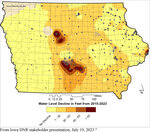

(SBA) - Des Moines, IA. A recent report released by the Sierra Club Iowa Chapter and impacted landowners exposes a looming water crisis facing Iowans—can Iowa’s aquifers sustain the amount of water being withdrawn?
Based on data from similar facilities and current ethanol usage, Summit’s 31 carbon capture facilities across Iowa will require 3.36 billion gallons of water from Iowa’s aquifers annually—equivalent to adding 10-11 new ethanol plants in Iowa. Much of this water comes from areas already struggling to meet demands for surrounding ethanol plants, industry and municipal use.
The report exposes that the Iowa Department of Natural Resources is not adequately reviewing water withdrawal permits to ensure they meet the definition of Beneficial Use as defined by Iowa law. And, Iowa has never done a comprehensive study to determine aquifer levels and whether Iowa can sustain the high water demand from industries like ethanol and Carbon Capture and Storage (CCS).
“Iowa DNR has the duty to protect Iowa’s water resources for the beneficial use of the people of Iowa. Instead, over the years DNR has been handing out water use permits like candy, with no consideration of the impact on our groundwater resources,” said Wally Taylor, attorney for the Sierra Club Iowa Chapter.
Iowa has two types of aquifers, alluvial and bedrock aquifers. Alluvial aquifers are near the surface and recharge relatively quickly with regular precipitation. Confined bedrock aquifers take many lifetimes to recharge.
“When examining major water-usage industries, it is clear that ethanol is the most reliant on confined bedrock aquifers. 90% of water for ethanol production comes from bedrock aquifers compared to 40% for industrial/commercial, 35% for public water systems, and 1% for power generation,” said Don Johannsen. “This is not sustainable, especially when we don’t know how much water is in our aquifers.”
“It’s even scarier when you take a look at the local impact. The Homeland Energy Solutions in Lawler with Summit’s capture equipment will use 85% of the total water used by industries and cities within the surrounding ten-mile radius. Our local communities are threatened with water shortages. What happens then?” said Johannsen.
The report calls for the Iowa DNR to deny any water withdrawal permits for Carbon Capture and for DNR to do a comprehensive study on Iowa’s aquifers, among other things.
“Summit is going to drain our aquifers. CCS is all risk and no reward. The pipelines threaten our safety, destroy our land, waste our water, squander our public money and abuse eminent domain. Iowa needs to step up and say no to these boondoggles.” Said Kim Junker, a Summit impacted farmer in Grundy and Butler counties.
“The report is damning. Summit is threatening our water resources. A looming water crisis could be ahead of us in Iowa. We’re concerned that Iowa may drain its aquifers if DNR continues to be asleep at the wheel,” said Jess Mazour, Sierra Club Iowa Chapter.
Click here to view the factsheet.
Click here to view the Water Woes Report.
Click here to view the report appendix.
Click here to view the full report with appendix (195 pages).
Click here for the report website.